Aug 30—What, no new day? We're still on the same day? Is this Groundhog Day all over again? (Think about the recursion in that question ;~) Well, yes and no. I decided to separate out a description of our typical day here at Kirkman's Kamp from the animal-by-animal blow-by-blows I'm doing. So, yes, you're getting a second view of the day. We'll return tomorrow to our regularly scheduled programming...
Let's start with the overall description of a typical day at Kirkman's. It goes like this: eat, drive, eat/drink, drive, eat, rest for an hour, drive, eat/drink, drive, drink, drive, eat. Say what? Sometimes I think the high cost of putting on these workshops has to do with all the cooks and bus boys we need.
We're on the British system here, so rather than three huge meals (they're still big), we consume often and throughout the day. Before sunrise, we're up and we find a buffet table awaiting us for breakfast.
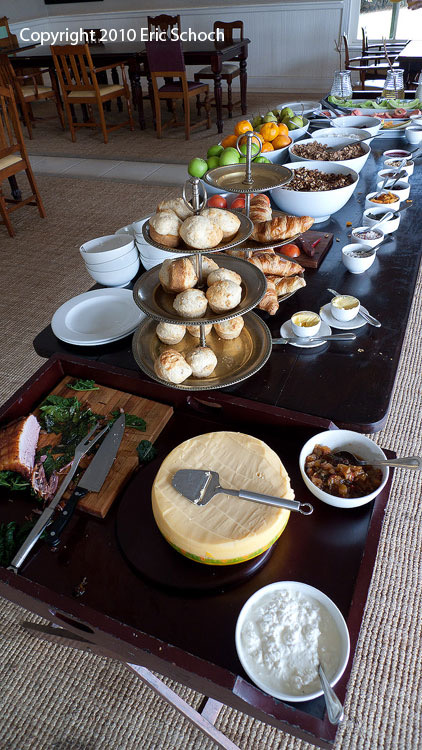
Don't worry, there's more than you see on that table. You can order eggs and cooked meat directly in addition to all the fruits, grains, meats, and cheeses at the buffet. And don't forget, we're being British here, so drink some tea. If you happen to miss the morning tea, don't worry, there will be mid-morning tea, mid-day tea, mid-afternoon tea, mid-sunset tea, mid-dinner tea, and mid-sleep tea (yes, there's a teapot and tea bags in our rooms, just in case we didn't get enough during the day).
After the "light breakfast" we're then off for the sunrise portion of our drive. There's usually a good sunrise shot available, and most of the animals are either still active (predators), or starting to get active (prey). You'll be shooting at ISO 3200 and 6400 during this earliest portion of the drive, almost guaranteed, so those D3s bodies shine at the edges of the day. After a bit of morning drive, we stop for tea and a snack (muffins, biscuits, sometimes a cookie or pastry).
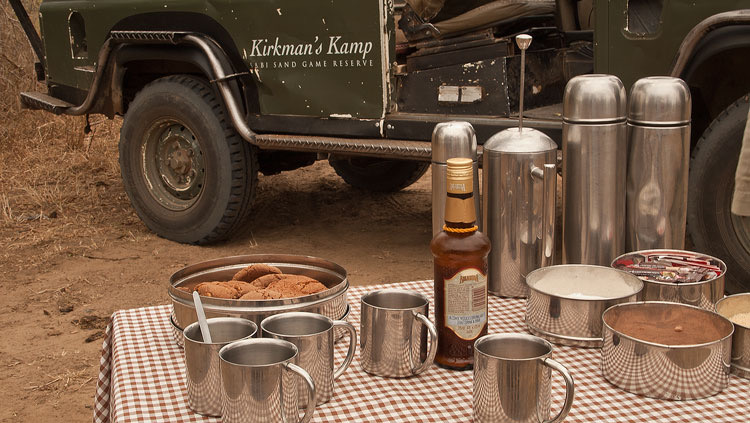
Back to driving. By this point in the morning the sun is up high enough that you've brought your ISO down out of the stratosphere, but you still have to watch in the shadowed areas: with the big lenses and moving animals, you want 1/500 or faster shutter speeds most of the time, so you usually only get to base ISO in the sun. Following this part of the drive, you head back to camp and have lunch (or sometimes a safari brunch, shown being cooked and set up in the next picture).
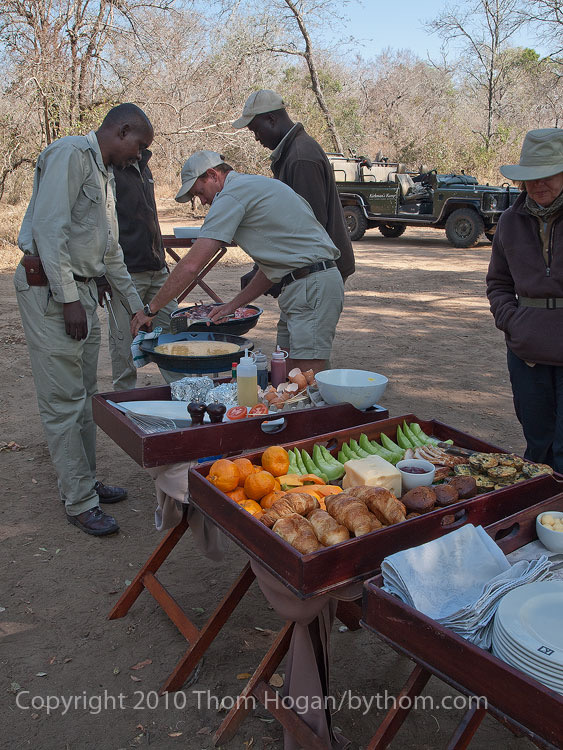
Traditional lunch is usually a nice buffet with plenty of choices, and like everything else on safari, all you can eat. And at Kirkman's Kamp, the chef is good. Gordon Ramsey good. [So how did I lose six pounds on safari? Beats me. I think I may have just gotten too tired to eat ;~] After lunch/brunch, most folks get a bit of a rest. I tried to give my group at least an hour, as there is a lot of battery and card management to do on good safaris, amongst other things. But during this particular workshop, I was also doing image review during this "downtime." So maybe it wasn't downtime at all. It's long been suggested that if you need daytime naps, you probably shouldn't be on one of my workshops, as you're sure to sleep through something.
By 3 pm we're having more tea and another snack (though sometimes we delay this into the drive a bit) before getting back into the vehicles for more driving. Which is interrupted near sunset by the traditional "sundowner." That's when it becomes officially okay to start drinking alcohol. Well, not for me, as I don't drink, but if you're following the traditional British schedule, you'll have your first gin and tonic at this point. Try not to have more than one, as it tends to interfere with your post-sunset shooting. Here's tracker Robert (left) and driver Dalsa (right) with Vince:
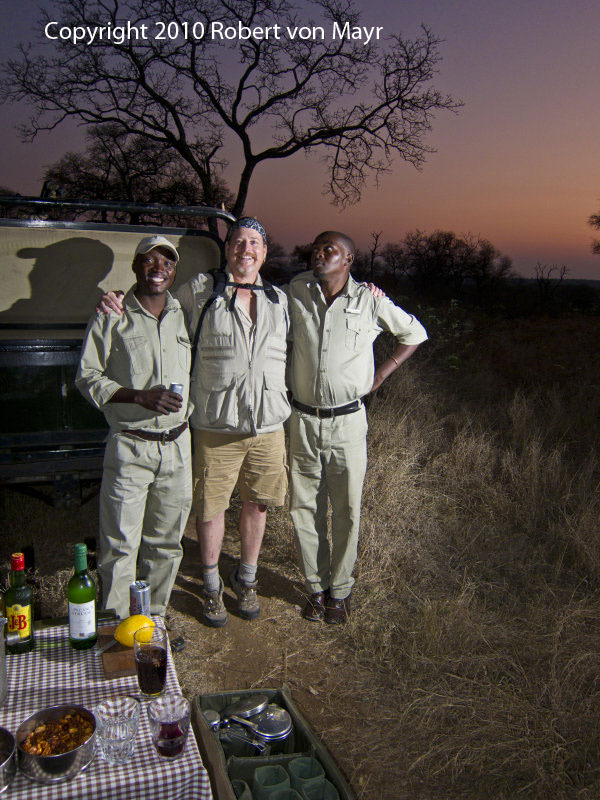
And yes, there is usually post-sunset shooting (more on that in a bit), so your ISO is probably back up to 3200 or 6400. We return to camp for, you guessed it: more tea, more gin and tonics, and dinner.
Most camps tend to have special dinner nights, usually the first night when a big new group comes in. It's typically held outdoors in a modern boma (outdoor enclosure; traditional ones have a circular wall made of dense thorny bushes) and tends to be an African variation of open grilling. After the dinner service, members of the camp staff usually come out and do some traditional African songs and dances.


Okay, so that's a typical day. At this point you probably want to know less about the food and more about the drives.
As I noted earlier, Kirkman's has quite a large area of their own. In the following image you can see the GPS plot for our two drives today (orange is the morning drive, blue is the afternoon drive). That orange track is about 19 miles long, the blue 18. The faint white line towards the right is the boundary road with Kruger National Park, the big meandering white/green track is the Sand River. Kirkman's Kamp is towards the lower left (and labeled).

You can see some small detours off road here and there in the tracks, and you can see where we stuck to the road (along the Kruger border, for example). Kirkman's has a maximum capacity of, I think, 36 guests, which under normal circumstances means four or five vehicles are traveling their 80+ miles of road. The likelihood you see another vehicle, therefore, is low unless you're all at the same sighting or passing each other on the roads.
The usual way most camps operate in the preserves is to put three people in each of three rows in the vehicle. That's nine people, plus driver and tracker. For serious photography, that just doesn't work. You can't really orient a vehicle with the animals to the side without one side of the vehicle getting a great view and the other having to see over two other people. The vehicles do use stadium seating, where each row of seating is higher than the one in front, but even that doesn't work well for many sightings. Here's a view of two of the other, non-photography Kirkman's vehicles (with seven guests each) on a lion sighting:
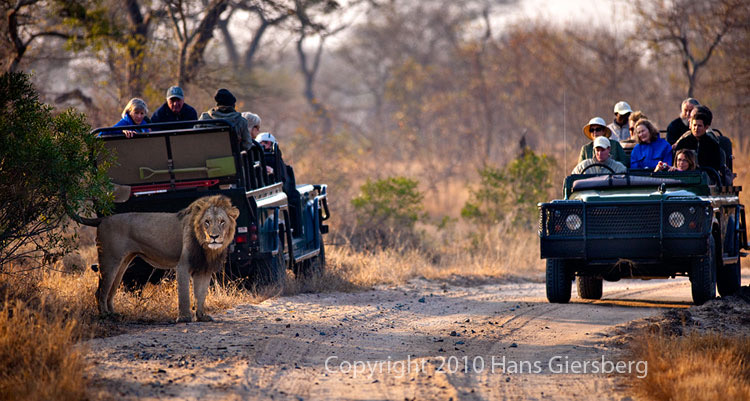
It would be very difficult to wield seven 200-400mm or larger lenses in that situation and have everyone feel like they had great shot opportunities. That's one reason why good African wildlife workshops cost a lot of money: we have to buy extra vehicles (and guides/trackers) to make for a comfortable shooting environment. Here's what that extra money buys you:
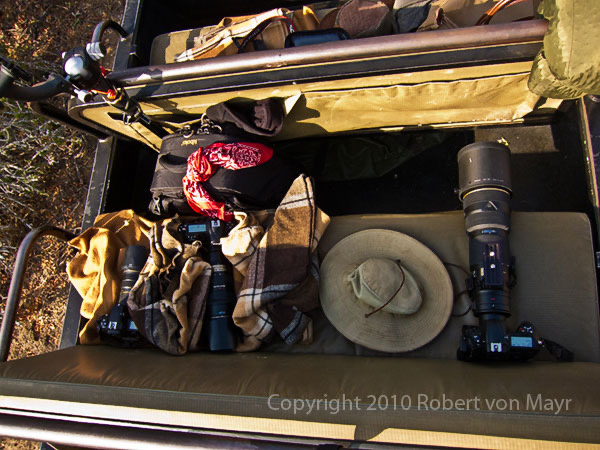
As you can see, Robert's got this seat to himself and has his ThinkTank camera bag, three cameras with lenses out, and his monopod hooked into the bar on one side in front of him. The person in the back seat (currently) shares the seat with the tracker, but the tracker isn't trying to shoot and isn't carrying lots of equipment with them. Basically, Lanz or I are in the front seat next to the driver (we're on the left side, as this is British style roadway) and we don't have much room, while each student has a row to themselves behind (except for the last row, as I mentioned). But this allows us to orient the vehicle to one side (typically left, or else I don't have a shot!) with everyone having an unimpeded shot. Monopods work best in these vehicles, though Lanz tends to use his tripod with the legs only slightly split. You can also clamp into the bars (and Really Right Stuff is working on an accessory to do this), but I find that a little constraining, and you'd have to be in a vehicle where people aren't shooting over each other to really take full advantage of that. In a vehicle with nine people in it, even if you're the only one shooting, being locked most of the time to the bar isn't going to work. Again, another reason why you want to be on an African workshop that restricts the number of photographers/guests that are in each vehicle.
A big bean bag works decently on the bars, though only if you have enough room to maneuver on the seat (i.e. aren't sitting with two other people in the row). As it turns out, even with our smallish group, we needed enough "beans" that we ended up essentially stripping the shelves of the local market of everything that resembles a bean. (We gave all the food in our bags afterwards to the drivers and trackers at the end of the trip, making them and their wives very happy).
The gist of what I'm trying to write is this: good photo safaris try to make sure that everyone can shoot pretty much all the time, without much hassle of shooting over or around someone else, and don't try to stuff vehicles with people. But that increases the costs of the tour. And it ups the price of tips for the driver and tracker, as we need to make up for the missing five people in their vehicle.
Now, about that tracker. Kirkman's was convinced by someone a couple of years ago to move the tracker off the front of the vehicle and onto the back seat (another neighboring camp, Mala Mala, just got rid of trackers to save on labor costs, which is silly). Unfortunately, that not only takes up seat space, but it puts the tracker and driver in an awkward position vis-a-vis one another. A tracker should be looking for tracks and should be in close communication with the driver. Here's where the tracker usually goes (and will go back to soon at Kirkman's, I'm told):
Hey, wait a minute, that's not a tracker, that's a student! Since Vince signed the liability waiver (;~), we let him sit in the tracker position for a short bit of one of our night drives to see what that's like. I knew he'd enjoy that, and he did, though I never saw someone clutch that grab handle quite as hard (we're not moving here and he's still clutching it!). Yes, it's very vulnerable out there, and yes, I've seen lions walk close enough to brush up against a tracker. Having a tracker at the front of the vehicle does make the view of the person next to the driver (that would be me) somewhat restricted, but a tracker up there that knows what they're doing sees everything, and I mean everything. I've had trackers stop a vehicle because they saw one faint partial paw print going across the road, get off the vehicle, walk off into the bush and find a lion resting well out of sight of the road. Yes, they're that good, as you'll soon find out (hey, quit that foreshadowing, Thom!).
Hey, wait, did I write "night drive" back there? Yes, I did. Earlier I wrote that Kirkman's allows photographic groups to "buy a vehicle." You can pretty much go out when and where you want (within reason--you don't want the driver driving 24 hours a day). So, armed with a flood lamp, we did a bit of night driving each evening, as you'll soon find out (hey, I said quit that!). Given how much we were out as it was, I didn't schedule a lot of that, as I'm pretty sure the students wanted to be fed and get some sleep in addition to photographing. But still, it's something you can't do in most of the parks in Africa, so it's a bit of a treat and something completely different photographically. Like everything else in the preserves, the camps have come up with rules for night driving, too. Lights are never shined in the eyes of prey (well, you sometimes can't avoid a very brief bit of that when you're identifying things, but you never let the light linger on prey). In fact, the whole night driving subject is a very tricky and interesting subject [which I'll talk about when we get to Botswana--yes, more foreshadowing].
So there you have some of the behind the scenes coverage. Tomorrow, back to the animals.